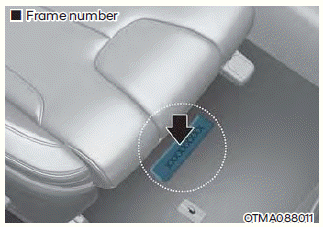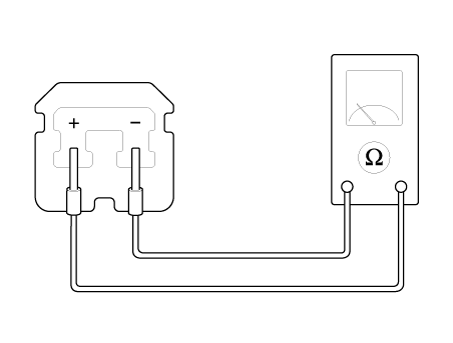Hyundai Santa Fe: Air conditioning System / Evaporator Temperature Sensor. Repair procedures
Hyundai Santa Fe (TM) 2019-2025 Service Manual / Heating,Ventilation And Air Conditioning / Air conditioning System / Evaporator Temperature Sensor. Repair procedures
| Inspection |
| 1. |
Turn the ignition switch OFF.
|
| 2. |
Disconnect the evaporator temperature sensor connector.
|
| 3. |
Measure resistance between terminal "+" and "-" of the evaporator temperature
sensor.
Specification
|
| 4. |
Connect the evaporator temperature sensor connector.
|
| 5. |
Run the engine and turn the A/C switch ON, then measure the voltage
between the terminals of the harness connector.
|
| Replacement |
| 1. |
Disconnect the negative (-) battery terminal.
|
| 2. |
Remove the evaporator core.
(Refer to Heater - "Evaporator Core")
|
| 3. |
Separate the evaporator temperature sensor (A) from the evaporator core.
|
| 4. |
Install in the reverse order of removal.
|
 Evaporator Temperature Sensor. Description and operation
Evaporator Temperature Sensor. Description and operation
Description
The evaporator temperature sensor will detect the evaporator core temperature
and interrupt compressor relay power in order to prevent evaporator from freezing
by excessive cooling...
 In-car Sensor. Description and operation
In-car Sensor. Description and operation
Description
The In-car air temperature sensor is built in the heater & A/C control unit.
The sensor consists of a thermistor that measures the inside temperature...
Other information:
Hyundai Santa Fe (TM) 2019-2025 Owner's Manual: ESC OFF usage
When Driving The ESC OFF mode should only be used briefly to help free the vehicle if stuck in snow or mud, by temporarily stopping operation of ESC, to maintain wheel torque. To turn ESC off while driving, press the ESC OFF button while driving on a flat road surface...
Hyundai Santa Fe (TM) 2019-2025 Service Manual: Airbag Module Disposal. Description and operation
Airbag Disposal When you scrap a vehicle equipped with an airbag, you must deploy it first. When you deploy an airbag, you need to have a skilled mechanic do the work. The used airbag should not be reinstalled in another vehicle for reuse...
Categories
- Manuals Home
- 4th Generation Santa Fe Owners Manual
- 4th Generation Santa Fe Service Manual
- Gauges and meters
- System settings
- Folding the rear seat
- New on site
- Most important about car
Vehicle Identification Number (VIN). Vehicle certification label. Tire specification and pressure label
Vehicle Identification Number (VIN)

The vehicle identification number (VIN) is the number used in registering your vehicle and in all legal matters pertaining to its ownership, etc.
The number is punched on the floor under the passenger seat. To check the number, open the cover.
Copyright © 2025 www.hsafe4.com


